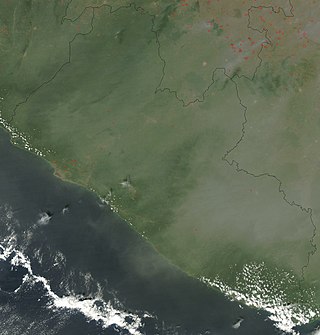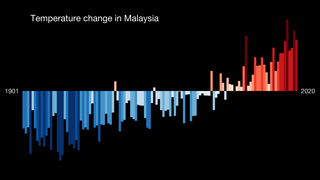
Liberia is a sub-Saharan nation in West Africa located at 6 °N, 9 °W.

Climate change in Africa is an increasingly serious threat as Africa is among the most vulnerable continents to the effects of climate change. Some sources even classify Africa as "the most vulnerable continent on Earth". Climate change and climate variability will likely reduce agricultural production, food security and water security. As a result, there will be negative consequences on people's lives and sustainable development in Africa.

Globally, Nepal is ranked fourth in terms of vulnerability to climate change. Floods spread across the foothills of the Himalayas and bring landslides, leaving tens of thousands of houses and vast areas of farmland and roads destroyed. In the 2020 edition of Germanwatch's Climate Risk Index, it was judged to be the ninth hardest-hit nation by climate calamities during the period 1999 to 2018. Nepal is a least developed country, with 28.6 percent of the population living in multidimensional poverty. Analysis of trends from 1971 to 2014 by the Department of Hydrology and Meteorology (DHM) shows that the average annual maximum temperature has been increasing by 0.056 °C per year. Precipitation extremes are found to be increasing. A national-level survey on the perception-based survey on climate change reported that locals accurately perceived the shifts in temperature but their perceptions of precipitation change did not converge with the instrumental records. Data reveals that more than 80 percent of property loss due to disasters is attributable to climate hazards, particularly water-related events such as floods, landslides and glacial lake outburst floods (GLOFs).

Climate change in Pakistan is a major issue for the country. Pakistan is highly vulnerable to climate change. As with the changing climate in South Asia as a whole, the climate of Pakistan has changed over the past several decades, with significant impacts on the environment and people. In addition to increased heat, drought and extreme weather in parts of the country, the melting of glaciers in the Himalayas has impacted some of the important rivers of Pakistan. Between 1999 and 2018, Pakistan ranked 5th in the countries affected by extreme weather caused by climate change. Pakistan is prone to a range of natural disasters, including cyclones, floods, drought, intense rainfall, and earthquakes. According to scientific research, climate change played a substantial role in the devastating floods of 2022, which had a direct impact on over 30 million people in Pakistan, resulting in the loss of lives, damage to public infrastructure, and displacement from homes. Climate change poses a significant menace to Pakistan's economy and security.

Climate changein the Caribbean poses major risks to the islands in the Caribbean. The main environmental changes expected to affect the Caribbean are a rise in sea level, stronger hurricanes, longer dry seasons and shorter wet seasons. As a result, climate change is expected to lead to changes in the economy, environment and population of the Caribbean. Temperature rise of 2 °C above preindustrial levels can increase the likelihood of extreme hurricane rainfall by four to five times in the Bahamas and three times in Cuba and Dominican Republic. Rise in sea level could impact coastal communities of the Caribbean if they are less than 3 metres (10 ft) above the sea. In Latin America and the Caribbean, it is expected that 29–32 million people may be affected by the sea level rise because they live below this threshold. The Bahamas is expected to be the most affected because at least 80% of the total land is below 10 meters elevation.

Climate change in Suriname is leading to warmer temperatures and more extreme weather events in Suriname. As a relatively poor country, its contributions to global climate change have been limited. Because of the large forest cover, the country has been running a carbon negative economy since 2014.

In Afghanistan, climate change has led to a temperature increase of 1.8 °C since 1950. This has caused far-reaching impacts on Afghanistan, culminating from overlapping interactions of natural disasters, conflict, agricultural dependency, and severe socio-economic hardship.

Climate change is having a considerable impact in Malaysia. Increasing temperatures are likely to greatly increase the number of heatwaves occurring annually. Variations in precipitation may increase the frequency of droughts and floods in various local areas. Sea level rise may inundate some coastal areas. These impacts are expected to have numerous environmental and socioeconomic effects, exacerbating existing environmental issues and reinforcing inequality.

Climate change in Ghana is impacting the people in Ghana in several ways as the country sits at the intersection of three hydro-climatic zones. Changes in rainfall, weather conditions and sea-level rise will affect the salinity of coastal waters. This is expected to negatively affect both farming and fisheries.
Climate change in Somalia refers to changes in the climate in Somalia and the subsequent response, adaption and mitigation strategies of the country. Climate models predict that the East Africa region is likely to experience both near-term alterations in climate such as warmer temperatures, changes in the frequency and intensity of extreme events, and decreased precipitation, as well as long-term shifts such as sea level rise.

Climate change in Senegal will have wide reaching impacts on many aspects of life in Senegal. Climate change will cause an increase in average temperatures over west Africa by between 1.5 and 4 °C by mid-century, relative to 1986–2005. Projections of rainfall indicate an overall decrease in rainfall and an increase in intense mega-storm events over the Sahel. The sea level is expected to rise faster in West Africa than the global average. Although Senegal is currently not a major contributor to global greenhouse gas emissions, it is one of the countries most vulnerable to climate change.

Vietnam is among the most affected countries by global climate change. A large number of studies show that Vietnam is experiencing climate change and will be severely negatively affected in coming decades. These negative effects include sea level rise, salinity intrusion and other hydrological problems like floods, river mouth evolution and sedimentation. Natural hazards such as cold waves, storm surges will increase in frequency, with negative effects on the country's development, infrastructure and economy.

Climate change has had serious consequences in Azerbaijan since the start of the 21st century. The climate of Azerbaijan was 1.3 degrees hotter by 2010. The Caspian Sea is shrinking. Azerbaijan will host the 2024 United Nations Climate Change Conference, known as COP29.
Climate change is predicted to lead to rising temperatures at a swifter rate in Cyprus than many other areas of the planet. Cyprus is an island nation geographically situated in the Middle East, with low levels of rainfall.

Climate change is evident in Kyrgyzstan. Among the countries in Eastern Europe and Central Asia, Kyrgyzstan is the third most vulnerable to the effects of climate change, such as changes in weather patterns that could lead to prolonged periods of precipitation and drought. Moreover, the frequent occurrence of extreme weather and climate events such as heatwaves, droughts, heavy rainfalls, and biotic/abiotic catastrophes during recent years are evidence of climate change. Kyrgyzstan is threatened with glacier melting and a lack of freshwater balance, which are accelerated by global warming. The average temperature has increased from 4.8 °C to 6 °C so far within the last 20 years. In 2013 the World Bank estimated a likely increase of 2 °C in average mean temperature by 2060 and of 4–5 °C by 2100, noting that the country's glaciers were significantly reduced and projected to decline further. A significant warming trend in Kyrgyztsan with a projected increase of 6°C under the Shared Socioeconomic Pathway (SSP) scenario SSP5-8.5 from 2076 to 2096. However the very slight increase in temperature is expected to positively affect climate-sensitive sectors such as agriculture, energy, and forestry as more land is within the optimum temperature band.
Climate change in Guatemala is a serious issue as Guatemala is considered one of 10 nations most vulnerable to the effects of climate change. In 2010, Guatemala "ranked second in the world on the Global Climate Risk Index, which indicates the level of exposure and vulnerability to extreme events." Both commercial agricultural production and subsistence farming have declined, and thus subsistence farmers find it more difficult to find work as day laborers when their own harvests fail. About 300,000 subsistence farmers reported crop loss due to drought in 2018. About half of Guatemala's workforce is in the agricultural sector. Poor crop yields due to climate change have been identified as a factor in migration to the United States.

Climate change in the Gambia is having impacts on the natural environment and people of The Gambia. Like other countries in West Africa, the impacts of climate change are expected to be varied and complex. Climate change adaptation is going to be important to achieve the Sustainable Development Goals in the country.

Climate change in the Middle East and North Africa (MENA) refers to changes in the climate of the MENA region and the subsequent response, adaption and mitigation strategies of countries in the region. In 2018, the MENA region emitted 3.2 billion tonnes of carbon dioxide and produced 8.7% of global greenhouse gas emissions (GHG) despite making up only 6% of the global population. These emissions are mostly from the energy sector, an integral component of many Middle Eastern and North African economies due to the extensive oil and natural gas reserves that are found within the region. The region of Middle East is one of the most vulnerable to climate change. The impacts include increase in drought conditions, aridity, heatwaves and sea level rise.

Climate change in South Africa is leading to increased temperatures and rainfall variability. Evidence shows that extreme weather events are becoming more prominent due to climate change. This is a critical concern for South Africans as climate change will affect the overall status and wellbeing of the country, for example with regards to water resources. Just like many other parts of the world, climate research showed that the real challenge in South Africa was more related to environmental issues rather than developmental ones. The most severe effect will be targeting the water supply, which has huge effects on the agriculture sector. Speedy environmental changes are resulting in clear effects on the community and environmental level in different ways and aspects, starting with air quality, to temperature and weather patterns, reaching out to food security and disease burden.

Malawi is a land-locked country in southeastern Africa situated along the southernmost arm of the East African Rift-Valley System between latitudes 9°22’ and 17°03’ south of the equator, and longitudes 33°40’ and 35°55’ east of the Greenwich meridian. It shares borders with Tanzania in the north and northeast, Mozambique in the southwest, south, and east, and Zambia in the west. Malawi is highly vulnerable to the effects of climate change as the vast majority of Malawians rely on small-scale, rain-fed agriculture, making them highly dependent on weather patterns. Climate change increasingly exacerbates droughts, flooding, and inconsistent rainfall—contributing to food insecurity and threatening to derail progress toward Malawi’s goal of self-reliance.



















